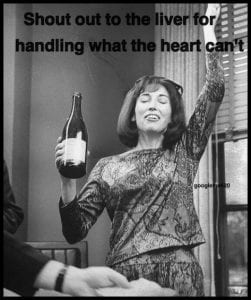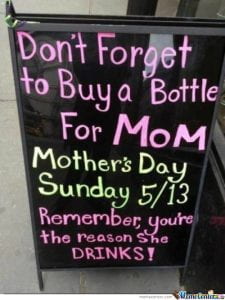The term “mommy juice” may appear innocent and lighthearted, however, taking a further look into the expression, one can see it being quite problematic. “Mommy juice” refers to an alcoholic drink that a mother consumes to cope with her daily tasks of motherhood. We understand, being a mom is hard. Mothers have sacrificed so much for their children and are deserving of mental and physical breaks. But, when did the dependence of wine consumption become the standard idea of motherhood time outs?
#BoozyMomNation
Cultural norms and generational trends can contribute to the hype of the mommy juice movement. You can walk into almost any department store’s home decor section and find paraphernalia relating to this culture. I searched “mommy juice” on Amazon.com and approximately 140 related items came up for purchase. As for the e-commerce website, Etsy.com, approximately 700 items. This advertisement is just an example of how easy it is to find alcoholic beverages and glassware marketed directly to mothers. The Boozy Mom Nation is even easier to find on Facebook. With a simple query, I found groups named “Moms Gone Wine” “Moms Deserve to Wine” and “Mom Hard, Wine Harder”. The normalization of the mommy juice movement desensitizes the consequences of this harmful behavior and increases the potential for binge drinking and the effects it may have on both the mother and her child(ren).
Source: https://www.etsy.com/search?q=mommy%20juice
Functioning Alcoholic
Women are often found drinking alcohol to celebrate happy events, decompress from a stressful day, or cope with sadness. Mommy juice consumption can consist of one maybe two, glasses of wine. To some, this may not seem harmful, but using alcohol as a coping device can lead to further consumption of stronger alcoholic drinks and binge drinking.
Here are a few harmful behavioral habits that can be a sign for alcohol use disorder (AUD).
Drinking to cope with pain or sadness– motherhood is tough, and adding other work and life stresses, doesn’t make it any easier. Women must find healthier coping mechanisms and outlets for their mommy “time-outs”.
Drinking more often- For women, binge drinking is defined as 4 or more drinks during a single occasion or more than 7 drinks in a week (National Institute on Alcohol Abuse and Alcoholism). When one mommy juice drink becomes two or three more, that harmful habit may be out of control.
Drinking and driving (with and without passengers)- Although the legal blood alcohol content amount is 0.08 g/dl, drinking and driving is never the answer. Once drinking interferes with your ability to function during the day and take care of your child(ren), it’s a sign that your drinking habits have become a problem.
If the negative consequences to an individual isn’t enough to take control of their drinking habits, then they should consider the effects it may have on their children. Children are often compared to a sponge; they absorb anything around them. A child may one day adopt the same behaviors they’ve seen their parents perform. If a child grows up in a household with a heavy drinking culture, that drinking behavior becomes normalized. Their coping mechanisms to stress and sadness becomes directly attached to alcohol. Furthermore, when alcohol gets in the way of normal parenting activities, the relationship between a mother and child cannot grow to its fullest potential in the most important times of child development. For example, after one too many glasses of wine, a mom may feel frustrated or not be as attentive to what their child is doing or needing at that moment.
Future of Mommy Juice
So, what should moms do instead of drinking their mommy juice? Let’s start by reducing the negative connotation around women seeking help and wanting to take breaks from motherhood. Let’s provide alternative outlets and support groups for mommy self-care time. Building connections and receiving support from others are important ways to ensure moms and their children can develop a safe and healthy relationship. We should also pay close attention to marketing tactics and be aware of the dangers unhealthy drinking habits have on people and their social networks.
Sources:
https://www.necn.com/on-air/as-seen-on/WEB-Mommy-Juice_NECN-459083083.html
https://www.nbcboston.com/news/local/When-the-Mommy-Juice-Culture-Becomes-an-Issue-459152193.html
https://www.foxnews.com/lifestyle/7-signs-youre-hitting-the-mommy-juice-too-hard
National Institute on Alcohol Abuse and Alcoholism (NIAAA). NIAAA Council Approves Definition of Binge Drinking. NIAAA Newsletter, No. 3, Winter 2004. Available at: http://pubs.niaaa.nih.gov/publications/Newsletter/winter2004/Newsletter_Number3.pdf.
















